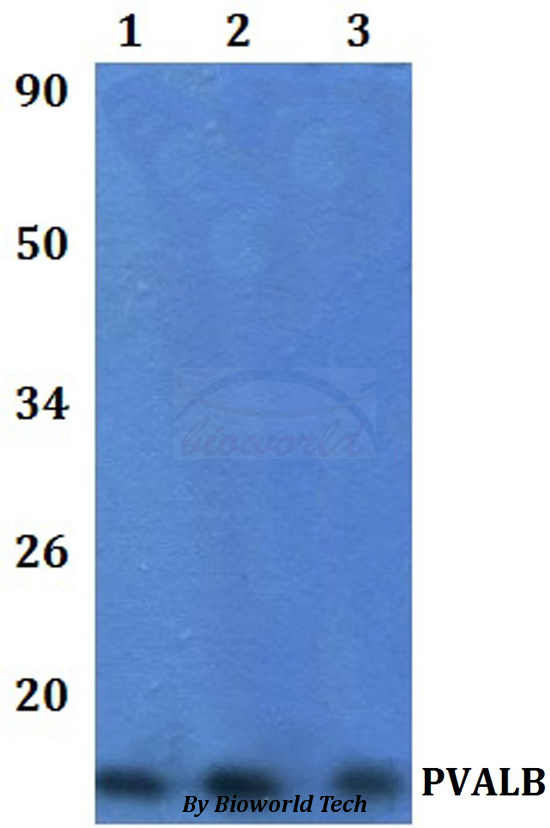Product Name :
PVALB polyclonal antibody Background :
The family of EF-hand type Ca2+-binding proteins includes calbindin (previously designated vitamin D-dependent Ca2+-binding protein), S-100α and β, calgranulins A (also designated MRP8), B (also designated MRP14) and C (S-100 like proteins) and the parvalbumin family members, including parvalbumin α and parvalbumin β, also designated oncomodulin (OCM). Structurally and evolutionarily conserved, parvalbumin α and OCM proteins are distinct in expression and function. Parvalbumin α, also designated parvalbumin (PV), is most abundantly expressed in fast-contracting muscles with lower expression levels in brain and some endocrine tissues, including kidney and parathyroid. Research indicates that parvalbumin α plays a significant role in muscle relaxation. OCM was originally thought to have expression restricted to neoplastic tissues, early embryonic cells and certain tumor cell lines. Recent research shows that OCM is also expressed and secreted by macrophages where, in the retina it binds to retinal ganglion cells (RGCs) and functions to promote axon regeneration. OCM has also been detected in the auditory sensory cells of the organ of Corti in mammals. In humans, two different loci on chromosome 7 have been identified as OCM and OCM-like (LOC4951). These genes encode proteins 109 amino acids in length which share 99% sequence identity. Product :
Rabbit IgG, 1mg/ml in PBS with 0.02% sodium azide, 50% glycerol, pH7.2 Storage&Stability :
Store at 4°C short term. Aliquot and store at -20°C long term. Avoid freeze-thaw cycles. Specificity :
PVALB polyclonal antibody detects endogenous levels of PVALB protein. Immunogen :
A synthetic peptide corresponding to residues in Human PVALB. Conjugate :
Unconjugated Modification :
Unmodification
PVALB polyclonal antibody Background :
The family of EF-hand type Ca2+-binding proteins includes calbindin (previously designated vitamin D-dependent Ca2+-binding protein), S-100α and β, calgranulins A (also designated MRP8), B (also designated MRP14) and C (S-100 like proteins) and the parvalbumin family members, including parvalbumin α and parvalbumin β, also designated oncomodulin (OCM). Structurally and evolutionarily conserved, parvalbumin α and OCM proteins are distinct in expression and function. Parvalbumin α, also designated parvalbumin (PV), is most abundantly expressed in fast-contracting muscles with lower expression levels in brain and some endocrine tissues, including kidney and parathyroid. Research indicates that parvalbumin α plays a significant role in muscle relaxation. OCM was originally thought to have expression restricted to neoplastic tissues, early embryonic cells and certain tumor cell lines. Recent research shows that OCM is also expressed and secreted by macrophages where, in the retina it binds to retinal ganglion cells (RGCs) and functions to promote axon regeneration. OCM has also been detected in the auditory sensory cells of the organ of Corti in mammals. In humans, two different loci on chromosome 7 have been identified as OCM and OCM-like (LOC4951). These genes encode proteins 109 amino acids in length which share 99% sequence identity. Product :
Rabbit IgG, 1mg/ml in PBS with 0.02% sodium azide, 50% glycerol, pH7.2 Storage&Stability :
Store at 4°C short term. Aliquot and store at -20°C long term. Avoid freeze-thaw cycles. Specificity :
PVALB polyclonal antibody detects endogenous levels of PVALB protein. Immunogen :
A synthetic peptide corresponding to residues in Human PVALB. Conjugate :
Unconjugated Modification :
Unmodification
-
 Western blot (WB) analysis of PVALB polyclonal antibody at 1:500 dilution Lane1:HEK293T whole cell lysate Lane2:The Muscle tissue lysate of Mouse Lane3:The Muscle tissue lysate of Rat
Western blot (WB) analysis of PVALB polyclonal antibody at 1:500 dilution Lane1:HEK293T whole cell lysate Lane2:The Muscle tissue lysate of Mouse Lane3:The Muscle tissue lysate of Rat
Bioworld Biotech only provide peptides for our antibodies and do not provide additional peptide customization services.
Price/Size :
USD 368/1mg/vial
Tips:
For phospho antibody, we provide phospho peptide(0.5mg) and non-phospho peptide(0.5mg).Describe :
Blocking peptides are peptides that bind specifically to the target antibody and block antibody binding. These peptide usually contains the epitope recognized by the antibody. Antibodies bound to the blocking peptide no longer bind to the epitope on the target protein. This mechanism is useful when non-specific binding is an issue, for example, in Western blotting (WB) and Immunohistochemistry (IHC). By comparing the staining from the blocked antibody versus the antibody alone, one can see which staining is specific; Specific binding will be absent from the western blot or IHC performed with the neutralized antibody.Formula:
Synthetic peptide was lyophilized with 100% acetonitrile and is supplied as a powder. Reconstitute with 0.1 ml DI water for a final concentration of 10 mg/ml.The purity is >90%,tested by HPLC and MS.
Storage:
The freeze-dried powder is more stable. For short time at 2-8°C. For long term storage store at -20°C.
Note :
This product is for research use only (RUO only). Not for use in diagnostic or therapeutic procedures.
 PVALB polyclonal antibody
PVALB polyclonal antibody  Datasheet
Datasheet COA
COA MSDS
MSDS SHIP
SHIP